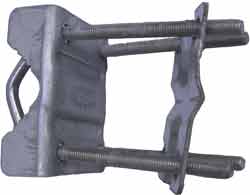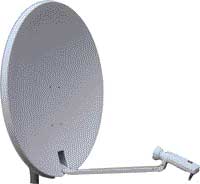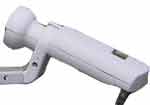
 This should be well made and capable of taking the weight of the dish and motor. A wall mount intended for a small 45cm dish will probably fail in windy conditions causing injury and damage. The fittings should be strong and suitable for the wall. The wall mount may include a small length of scaffold pole and clamps. The pole could be painted or galvanised.
This should be well made and capable of taking the weight of the dish and motor. A wall mount intended for a small 45cm dish will probably fail in windy conditions causing injury and damage. The fittings should be strong and suitable for the wall. The wall mount may include a small length of scaffold pole and clamps. The pole could be painted or galvanised.
 This can be solid or mesh, steel or aluminium. For windy sites a mesh may be better but it may not capture as much of the signal as a solid dish. The size will affect the signal strength - a larger diameter will collect a larger signal. The prices are also different. Remember that larger dishes may require planning permission.
This can be solid or mesh, steel or aluminium. For windy sites a mesh may be better but it may not capture as much of the signal as a solid dish. The size will affect the signal strength - a larger diameter will collect a larger signal. The prices are also different. Remember that larger dishes may require planning permission.
The picture shows the Triax 88 cm dish and boom with a dual output LNB (Invacom) on the end of the boom.
There are a few ways that the dish can be turned:
Satellite Polar mount and actuator
The polar mount is a clever bit of metalwork that can move the dish around so that it tracks the arc that the satellites are in. The actuator is an electric motor that has gears and pushes a rod in and out. When attached to the polar mount and dish, the actuator moves the dish around part of the arc (about 70°).
 Instead of using a Polar mount and actuator, you could use an H-H Motor.
Instead of using a Polar mount and actuator, you could use an H-H Motor.
The H-H motor (horizon to horizon) connects to the dish and moves the dish around the arc from horizon to horizon - 180°.
Once stopped pointing at a satellite, an actuator holds the dish firmer in the correct direction than an H-H motor. This is more apparent when viewing a weak signal on a windy day.
The Polar mount, actuator or H-H Motor, dish and the wall mount need to fit together and work. It is normally better to use a polar mount and dish made by the same manufacturer and designed to work together.
Some Polar mounts clamp directly onto the dish; others use a clamp and pole. Ones that clamp directly to the dish are less likely to be moved out of alignment by the wind.
Some motors and actuators support DiSEqC. This makes uses the signal cable to also send the power to turn the motor. The advantage is that there is one less cable needed but the current that can be sent along the cable is low and therefore the dish takes longer to move between satellite positions.
 This can be built in the receiver or a stand alone box and sends power along the signal cable or a separate motor cable to turn the dish. Some position boxes can take the DiSEqC signal sent from the receiver and convert it to control the motor or actuator over a separate motor cable.
This can be built in the receiver or a stand alone box and sends power along the signal cable or a separate motor cable to turn the dish. Some position boxes can take the DiSEqC signal sent from the receiver and convert it to control the motor or actuator over a separate motor cable.
SuperJack V-Box II positioner
If a motor or actuator is used with a motor cable, use a good cable. It needs 4 wires - 2 wires for the power - 2 control wires that tell the positioner how far the dish has been moved and in which direction. The power wires should be thick and the control wires should have an aluminium shield around them.
The LNB (Low Noise Block) can have one of more outputs (The one shown here has two). If you only plan to have a receiver then a single output is sufficient. If you  plan to have, for example, a Freesat free to air receiver and a sky box and use both at the same time for different channels, a quad output LNB will be needed. The sensitivity of the LNB is important if you want to receive satellite channels with low power in your area. In this case choose an LNB with a sensitivity of 0.3. If you just want to receive the high power satellites and are in a good location then you could use a 0.6 LNB.
plan to have, for example, a Freesat free to air receiver and a sky box and use both at the same time for different channels, a quad output LNB will be needed. The sensitivity of the LNB is important if you want to receive satellite channels with low power in your area. In this case choose an LNB with a sensitivity of 0.3. If you just want to receive the high power satellites and are in a good location then you could use a 0.6 LNB.
Invacom Universal Twin LNB 0.3 dB
This is co-axial cable that looks like normal TV cable but has different electrical characteristics. To get the strongest signal at the receiver, use good cable intended for satellite reception and not TV or other co-axial cable.
 You will need a number of F-connectors to terminate the signal cable(s). Get a few more so that you can make a couple of short cables if you intend to use a test meter.
You will need a number of F-connectors to terminate the signal cable(s). Get a few more so that you can make a couple of short cables if you intend to use a test meter.
 One or two back-to-back F-connector couplers are also useful.
One or two back-to-back F-connector couplers are also useful.
There is a wide range of receivers that can receive the current digital signals, the older analogue signals or both. Read Satellite magazines to decide which is suitable for you. The receiver used for this installation was the Dreambox 7000.
Tools Required for Installation
You may need to buy some additional equipment and tools to successfully install the satellite receiver and motorised dish.
Satellite Signal Level Test Meter
 To help find and direct the dish correctly a test meter is useful. There are several models with different facilities.
To help find and direct the dish correctly a test meter is useful. There are several models with different facilities.
Digisat Pro Satellite Signal Level Test Meter
Angle finder (Analogue Inclinometer) / Sprit level

Used to ensure that the wall mount is fitted vertically.

This is used to locate South and the directions of the satellites. You can use a hiking compass or buy one with popular satellite positions marked.
Ladder and / or platform, drill and bit, screwdrivers, spanners, bolts, washers, cable clips.
Satellite Receiver and Dish Equipment
The components you will require for a motorised Satellite Dish and Receiver are:
© 2005-2025
A Fielding
All Rights Reserved